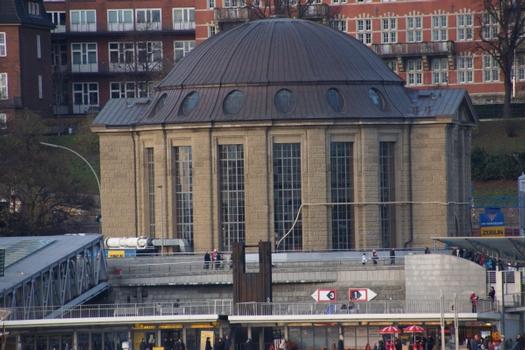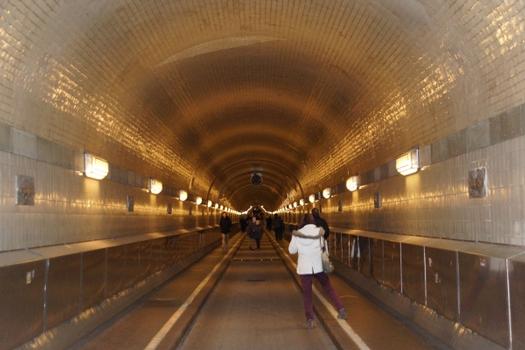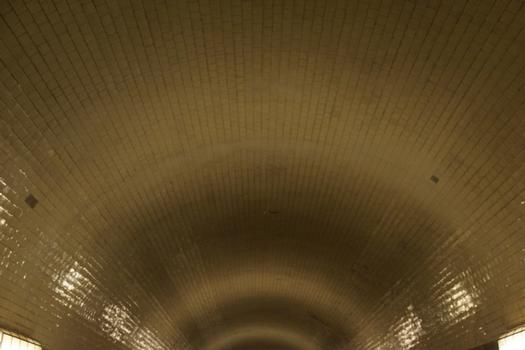General Information
| Name in local language: | Sankt-Pauli-Elbtunnel |
|---|---|
| Beginning of works: | 22 July 1907 |
| Completion: | 7 September 1911 |
| Status: | in use |
Project Type
| Function / usage: |
Road tunnel |
|---|---|
| Structure: |
Tunnel |
Awards and Distinctions
Location
| Location: |
Hamburg-Sankt Pauli, Hamburg, Germany Hamburg-Steinwerder, Hamburg, Germany |
|---|---|
| Underneath of: |
|
| Coordinates: | 53° 32' 44.98" N 9° 57' 59.62" E |
| Coordinates: | 53° 32' 30.40" N 9° 57' 59.31" E |
Technical Information
Dimensions
| tunnel length | 426.50 m | |
| number of tubes | 2 | |
| tube | exterior diameter | 5.92 m |
Cost
| cost of construction | ca. Goldmark 10 000 000 |
Excerpt from Wikipedia
Old Elbe Tunnel or St. Pauli Elbe Tunnel (German: Alter Elbtunnel colloquially or St. Pauli Elbtunnel officially) which opened in 1911, is a pedestrian and vehicle tunnel in Hamburg, Germany. The 426 m (1,398 ft) long tunnel was a technical sensation; 24 m (80 ft) beneath the surface, two 6 m (20 ft) diameter tubes connect central Hamburg with the docks and shipyards on the south side of the river Elbe. This was a big improvement for tens of thousands of workers in one of the busiest harbors in the world.
Four large lifts on either side of the tunnel carry pedestrians and vehicles to the bottom. The two tunnels are both still in operation, though due to their limited capacity by today's standards, other bridges and tunnels have been built and taken over most of the traffic.
In 2008 approximately 300,000 cars, 63,000 bicycles, and 700,000 pedestrians used the tunnel. The tunnel is opened 24 hours for pedestrians and bicycles. For motorized vehicles, opening times are currently Monday to Friday from 5:20 AM to 8:00 PM and on Saturdays from 5:20 AM to 4:00 PM.
History
Work was done under pressure because the tunnel was below the water table of the Elbe. This type of building technique was used in the 19th century, in large engineering excavations, such as with the piers of bridges and with tunnels, where caissons under pressure were used to keep water from flooding the excavations, such as the foundations of the Brooklyn Bridge in New York City.
Workers who spend time in high-pressure atmospheric pressure conditions are at risk when they return to the lower pressure outside the caisson without slowly reducing the surrounding pressure. Due to the problems associated with decompression sickness, many of the men working on the Elbe tunnel were affected by what was known at the time as "Caissons Disease". Of 4,400 workers three men died, 74 suffered severe cases and more than 600 came down with light symptoms.
The tunnel opened on 7 September 1911.
Modern usage
In the tunnel an art exhibition and a long-distance running event Elbtunnel-Marathon take place. In 2008 the tunnel participated in the Tag des offenen Denkmals ("Day of the open heritage site"), a Germany-wide annual event sponsored by the Deutsche Stiftung Denkmalschutz that opens cultural heritage sites to the public.
Text imported from Wikipedia article "Elbe Tunnel (1911)" and modified on November 10, 2020 according to the CC-BY-SA 4.0 International license.
Participants
-
Raabe & Wöhlecke
(northern building)
- Otto Wöhlecke (architect)
- Ludwig Raabe (architect)
Relevant Web Sites
Relevant Publications
- (2011): Der Alte Elbtunnel Hamburg. 1st edition, Bundesingenieurkammer, Berlin (Germany), ISBN 978-3-941867-03-1, pp. 120.
- (2011): Der alte Elbtunnel Hamburg. Bundesingenieurkammer, Berlin (Germany), ISBN 978-3-941867-03-1, pp. 120.
- (2010): Hamburgs dunkle Welten. Der geheimnisvolle Untergrund der Hansestadt. 2nd edition, Christoph Links Verlag GmbH, Berlin (Germany), ISBN 978-3-86153-589-8, pp. 30-34.
- (2012): Mechanised Shield Tunnelling. 2nd edition, Wilhelm Ernst & Sohn Verlag für Architektur und technische Wissenschaften GmbH, Berlin (Germany), ISBN 978-3-433-02995-4, pp. 217.
- About this
data sheet - Structure-ID
20019096 - Published on:
20/01/2006 - Last updated on:
28/05/2021









